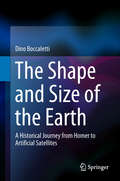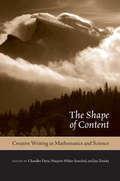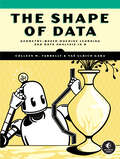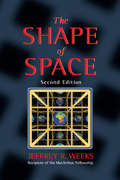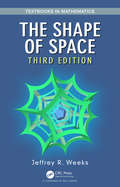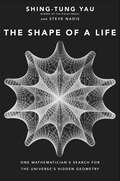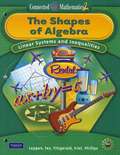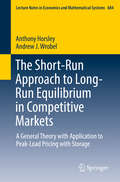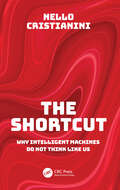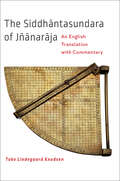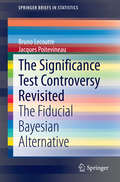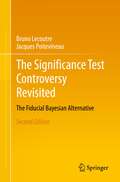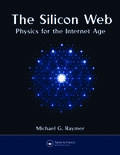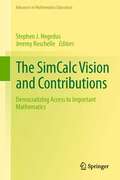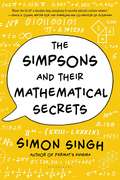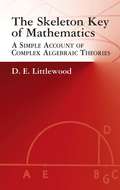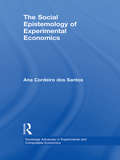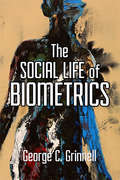- Table View
- List View
The Shape and Size of the Earth: A Historical Journey from Homer to Artificial Satellites
by Dino BoccalettiThis book describes in detail the various theories on the shape of the Earth from classical antiquity to the present day and examines how measurements of its form and dimensions have evolved throughout this period. The origins of the notion of the sphericity of the Earth are explained, dating back to Eratosthenes and beyond, and detailed attention is paid to the struggle to establish key discoveries as part of the cultural heritage of humanity. In this context, the roles played by the Catholic Church and the philosophers of the Middle Ages are scrutinized. Later contributions by such luminaries as Richer, Newton, Clairaut, Maupertuis, and Delambre are thoroughly reviewed, with exploration of the importance of mathematics in their geodetic enterprises. The culmination of progress in scientific research is the recognition that the reference figure is not a sphere but rather a geoid and that the earth’s shape is oblate. Today, satellite geodesy permits the solution of geodetic problems by means of precise measurements. Narrating this fascinating story from the very beginning not only casts light on our emerging understanding of the figure of the Earth but also offers profound insights into the broader evolution of human thought.
The Shape of Content: Creative Writing in Mathematics and Science
by Jan Zwicky Chandler Davis Marjorie Wikler SenechalThis book is a collection of creative pieces-poems, short stories, essays, play excerpts-that give shape to mathematical and scientific content. This book portrays by example how various people work creatively with ideas from mathematics and other sciences. Creative writing about the content of mathematics and science is rare, and creative writing
The Shape of Data: Geometry-Based Machine Learning and Data Analysis in R
by Colleen M. Farrelly Yaé Ulrich GabaThis advanced machine learning book highlights many algorithms from a geometric perspective and introduces tools in network science, metric geometry, and topological data analysis through practical application.Whether you&’re a mathematician, seasoned data scientist, or marketing professional, you&’ll find The Shape of Data to be the perfect introduction to the critical interplay between the geometry of data structures and machine learning.This book&’s extensive collection of case studies (drawn from medicine, education, sociology, linguistics, and more) and gentle explanations of the math behind dozens of algorithms provide a comprehensive yet accessible look at how geometry shapes the algorithms that drive data analysis.In addition to gaining a deeper understanding of how to implement geometry-based algorithms with code, you&’ll explore:Supervised and unsupervised learning algorithms and their application to network data analysisThe way distance metrics and dimensionality reduction impact machine learningHow to visualize, embed, and analyze survey and text data with topology-based algorithmsNew approaches to computational solutions, including distributed computing and quantum algorithms
The Shape of Inner Space: String Theory and the Geometry of the Universe's Hidden Dimensions
by Shing-Tung Yau Steve NadisString theory says we live in a ten-dimensional universe, but that only four are accessible to our everyday senses. According to theorists, the missing six are curled up in bizarre structures known as Calabi-Yau manifolds. In The Shape of Inner Space, Shing-Tung Yau, the man who mathematically proved that these manifolds exist, argues that not only is geometry fundamental to string theory, it is also fundamental to the very nature of our universe.Time and again, where Yau has gone, physics has followed. Now for the first time, readers will follow Yau's penetrating thinking on where we've been, and where mathematics will take us next. A fascinating exploration of a world we are only just beginning to grasp, The Shape of Inner Space will change the way we consider the universe on both its grandest and smallest scales.
The Shape of Space (Chapman & Hall/CRC Pure and Applied Mathematics #249)
by Jeffrey R. WeeksMaintaining the standard of excellence set by the previous edition, this textbook covers the basic geometry of two- and three-dimensional spaces Written by a master expositor, leading researcher in the field, and MacArthur Fellow, it includes experiments to determine the true shape of the universe and contains illustrated examples and engaging exercises that teach mind-expanding ideas in an intuitive and informal way. Bridging the gap from geometry to the latest work in observational cosmology, the book illustrates the connection between geometry and the behavior of the physical universe and explains how radiation remaining from the big bang may reveal the actual shape of the universe.
The Shape of Space: How To Visualize Surfaces And Three-dimensional Manifolds (Textbooks in Mathematics #Vol. 249)
by Jeffrey R. WeeksThe Shape of Space, Third Edition maintains the standard of excellence set by the previous editions. This lighthearted textbook covers the basic geometry and topology of two- and three-dimensional spaces—stretching students’ minds as they learn to visualize new possibilities for the shape of our universe. Written by a master expositor, leading researcher in the field, and MacArthur Fellow, its informal exposition and engaging exercises appeal to an exceptionally broad audience, from liberal arts students to math undergraduate and graduate students looking for a clear intuitive understanding to supplement more formal texts, and even to laypeople seeking an entertaining self-study book to expand their understanding of space. Features of the Third Edition: Full-color figures throughout "Picture proofs" have replaced algebraic proofs Simpler handles-and-crosscaps approach to surfaces Updated discussion of cosmological applications Intuitive examples missing from many college and graduate school curricula About the Author: Jeffrey R. Weeks is a freelance geometer living in Canton, New York. With support from the U.S. National Science Foundation, the MacArthur Foundation and several science museums, his work spans pure mathematics, applications in cosmology and—closest to his heart—exposition for the general public.
The Shape of a Life: One Mathematician's Search for the Universe's Hidden Geometry
by Shing-Tung Yau Steve NadisA Fields medalist recounts his lifelong effort to uncover the geometric shape—the Calabi-Yau manifold—that may store the hidden dimensions of our universe.Harvard geometer Shing-Tung Yau has provided a mathematical foundation for string theory, offered new insights into black holes, and mathematically demonstrated the stability of our universe. In this autobiography, Yau reflects on his improbable journey to becoming one of the world’s most distinguished mathematicians. Beginning with an impoverished childhood in China and Hong Kong, Yau takes readers through his doctoral studies at Berkeley during the height of the Vietnam War protests, his Fields Medal–winning proof of the Calabi conjecture, his return to China, and his pioneering work in geometric analysis. This new branch of geometry, which Yau built up with his friends and colleagues, has paved the way for solutions to several important and previously intransigent problems.With complicated ideas explained for a broad audience, this book offers not only insights into the life of an eminent mathematician, but also an accessible way to understand advanced and highly abstract concepts in mathematics and theoretical physics.“The remarkable story of one of the world’s most accomplished mathematicians . . . Yau’s personal journey—from escaping China as a youngster, leading a gang outside Hong Kong, becoming captivated by mathematics, to making breakthroughs that thrust him on the world stage—inspires us all with humankind’s irrepressible spirit of discovery.” —Brian Greene, New York Times–bestselling author of The Elegant Universe“An unexpectedly intimate look into a highly accomplished man, his colleagues and friends, the development of a new field of geometric analysis, and a glimpse into a truly uncommon mind.” —The Boston Globe“Engaging, eminently readable. . . . For those with a taste for elegant and largely jargon-free explanations of mathematics, The Shape of a Life promises hours of rewarding reading.” —American Scientist
The Shapes of Algebra, Linear Systems and Inequalities
by Glenda Lappan James T. Fey William M. Fitzgerald Susan N. Friel Elizabeth Difanis PhillipsNIMAC-sourced textbook
The Shapley value: Essays in honor of Lloyd S. Shapley
by Alvin E. RothComposed in honour of the sixty-fifth birthday of Lloyd Shapley, this volume makes accessible the large body of work that has grown out of Shapley's seminal 1953 paper. Each of the twenty essays concerns some aspect of the Shapley value. Three of the chapters are reprints of the 'ancestral' papers: Chapter 2 is Shapley's original 1953 paper defining the value; Chapter 3 is the 1954 paper by Shapley and Shubik applying the value to voting models; and chapter 19 is Shapley's 1969 paper defining a value for games without transferable utility. The other seventeen chapters were contributed especially for this volume. The first chapter introduces the subject and the other essays in the volume, and contains a brief account of a few of Shapley's other major contributions to game theory. The other chapters cover the reformulations, interpretations and generalizations that have been inspired by the Shapley value, and its applications to the study of coalition formulation, to the organization of large markets, to problems of cost allocation, and to the study of games in which utility is not transferable.
The Sherrington-Kirkpatrick Model
by Dmitry PanchenkoThe celebrated Parisi solution of the Sherrington-Kirkpatrick model for spin glasses is one of the most important achievements in the field of disordered systems. Over the last three decades, through the efforts of theoretical physicists and mathematicians, the essential aspects of the Parisi solution were clarified and proved mathematically. The core ideas of the theory that emerged are the subject of this book, including the recent solution of the Parisi ultrametricity conjecture and a conceptually simple proof of the Parisi formula for the free energy. The treatment is self-contained and should be accessible to graduate students with a background in probability theory, with no prior knowledge of spin glasses. The methods involved in the analysis of the Sherrington-Kirkpatrick model also serve as a good illustration of such classical topics in probability as the Gaussian interpolation and concentration of measure, Poisson processes, and representation results for exchangeable arrays.
The Short-Run Approach to Long-Run Equilibrium in Competitive Markets
by Anthony Horsley Andrew J. WrobelThe authors present a new formal framework for finding the long-run competitive market equilibrium through short-run equilibria by exploiting the operating policies and plant valuations. This "short-run approach" develops ideas of Boiteux and Koopmans. Applied to the peak-load pricing of electricity generated by thermal, hydro and pumped-storage plants, it gives a sound and practical method of valuing the fixed assets--in this case, the river flows and the geological sites suitable for reservoirs. Its main mathematical basis is the producer's short-run profit maximization programme and its dual; their solutions have relatively simple forms that can greatly ease the fixed-point problem of solving for the general equilibrium. Since the optimal values (profit and cost functions) are usually nondifferentiable--this is so when there are joint costs of production such as capacity constraints--nonsmooth calculus is employed to resolve long-standing discrepancies between textbook theory and industrial reality by giving subdifferential extensions of basic results of microeconomics, including the Wong-Viner Envelope Theorem.
The Shortcut: Why Intelligent Machines Do Not Think Like Us
by Nello CristianiniAn influential scientist in the field of artificial intelligence (AI) explains its fundamental concepts and how it is changing culture and society.A particular form of AI is now embedded in our tech, our infrastructure, and our lives. How did it get there? Where and why should we be concerned? And what should we do now? The Shortcut: Why Intelligent Machines Do Not Think Like Us provides an accessible yet probing exposure of AI in its prevalent form today, proposing a new narrative to connect and make sense of events that have happened in the recent tumultuous past, and enabling us to think soberly about the road ahead.This book is divided into ten carefully crafted and easily digestible chapters. Each chapter grapples with an important question for AI. Ranging from the scientific concepts that underpin the technology to wider implications for society, it develops a unified description using tools from different disciplines and avoiding unnecessary abstractions or words that end with -ism. The book uses real examples wherever possible, introducing the reader to the people who have created some of these technologies and to ideas shaping modern society that originate from the technical side of AI. It contains important practical advice about how we should approach AI in the future without promoting exaggerated hypes or fears.Entertaining and disturbing but always thoughtful, The Shortcut confronts the hidden logic of AI while preserving a space for human dignity. It is essential reading for anyone with an interest in AI, the history of technology, and the history of ideas. General readers will come away much more informed about how AI really works today and what we should do next.
The Siddhāntasundara of Jñānarāja: An English Translation with Commentary
by Toke Lindegaard KnudsenThe first English translation of this major work of classical Indian astronomy and mathematics.A treasure for anyone interested in early modern India and the history of mathematics, this first English translation of the Siddhāntasundara reveals the fascinating work of the scholar-astronomer Jñānarāja (circa 1500 C.E.). Toke Lindegaard Knudsen begins with an introduction to the traditions of ancient Hindu astronomy and describes what is known of Jñānarāja’s life and family. He translates the Sanskrit verses into English and offers expert commentary on the style and substance of Jñānarāja's treatise.The Siddhāntasundara contains a comprehensive exposition of the system of Indian astronomy, including how to compute planetary positions and eclipses. It also explores deep, probing questions about the workings of the universe and sacred Hindu traditions. In a philosophical discussion, the treatise seeks a synthesis between the cosmological model used by the Indian astronomical tradition and the cosmology of a class of texts sacred in Hinduism. In his discourse, which includes a discussion of the direction of down and adhesive antipodeans, Jñānarāja rejects certain principles from the astronomical tradition and reinterprets principles from the sacred texts. He also constructs a complex poem on the seasons, many verses of which have two layers of meaning, one describing a season, the other a god's activities in that season. The Siddhāntasundara is the last major treatise of Indian astronomy and cosmology to receive serious scholarly attention, Knudsen’s careful effort unveils the 500-year-old Sanskrit verses and shows the clever quirkiness of Jñānarāja's writing style, his keen use of mathematics, and his subtle philosophical arguments.
The Significance Test Controversy Revisited
by Bruno Lecoutre Jacques PoitevineauThe purpose of this book is not only to revisit the "significance test controversy,"but also to provide a conceptually sounder alternative. As such, it presents a Bayesian framework for a new approach to analyzing and interpreting experimental data. It also prepares students and researchers for reporting on experimental results. Normative aspects: The main views of statistical tests are revisited and the philosophies of Fisher, Neyman-Pearson and Jeffrey are discussed in detail. Descriptive aspects: The misuses of Null Hypothesis Significance Tests are reconsidered in light of Jeffreys' Bayesian conceptions concerning the role of statistical inference in experimental investigations. Prescriptive aspects: The current effect size and confidence interval reporting practices are presented and seriously questioned. Methodological aspects are carefully discussed and fiducial Bayesian methods are proposed as a more suitable alternative for reporting on experimental results. In closing, basic routine procedures regarding the means and their generalization to the most common ANOVA applications are presented and illustrated. All the calculations discussed can be easily carried out using the freeware LePAC package.
The Significance Test Controversy Revisited: The Fiducial Bayesian Alternative
by Bruno Lecoutre Jacques PoitevineauThis book explains the misuses and abuses of Null Hypothesis Significance Tests, which are reconsidered in light of Jeffreys’ Bayesian concept of the role of statistical inference, in experimental investigations. Minimizing the technical aspects, the studies focuses mainly on methodological contributions. The first part of the book gives an overview of the major approaches to statistical testing and an enlightening discussion of the philosophies of Fisher, Neyman-Pearson and Jeffrey. The conceptual and methodological implications of current practices of reporting effect sizes and confidence intervals are also examined and challenged. This sheds new light on the "significance testing controversy" and provides an appropriate Bayesian framework for a comprehensive approach to the analysis and interpretation of experimental data. The second part of the book provides concrete Bayesian routine procedures that bypass common misuses of significance testing and are readily applicable in a wide range of real applications. This approach addresses the need for objective reporting of experimental data, that is acceptable to the scientific community. This is emphasized by the name fiducial (from the Latin fiducia = confidence). The fiducial Bayesian procedures provide the reader with a real opportunity to think sensibly about problems of statistical inference. This book prepares students and researchers to critically read statistical analyses reported in the literature and equips them with an appropriate alternative to the use of significance testing.
The Silicon Web: Physics for the Internet Age
by Michael G. RaymerThe technology behind computers, fiber optics, and networks did not originate in the minds of engineers attempting to build an Internet. The Internet is a culmination of intellectual work by thousands of minds spanning hundreds of years. We have built concept upon concept and technology upon technology to arrive at where we are today, in a world co
The Silver Market Phenomenon: Marketing and Innovation in the Aging Society
by Cornelius Herstatt Florian KohlbacherThe current shift in demographics - aging and shrinking populations - in many countries around the world presents a major challenge to companies and societies alike. One particularly essential implication is the emergence and constant growth of the so-called "graying market" or "silver market", the market segment more or less broadly defined as those people aged 50 and older. Increasing in number and share of the total population while at the same time being relatively well-off, this market segment can be seen as very attractive and promising, although still very underdeveloped in terms of product and service offerings. This book offers a thorough and up-to-date analysis of the challenges and opportunities in leveraging innovation, technology, product development and marketing for older consumers and employees. Key lessons are drawn from a variety of industries and countries, including the lead market Japan.
The SimCalc Vision and Contributions
by Jeremy Roschelle Stephen J. HegedusThis volume provides essential guidance for transforming mathematics learning in schools through the use of innovative technology, pedagogy, and curriculum. It presents clear, rigorous evidence of the impact technology can have in improving students learning of important yet complex mathematical concepts -- and goes beyond a focus on technology alone to clearly explain how teacher professional development, pedagogy, curriculum, and student participation and identity each play an essential role in transforming mathematics classrooms with technology. Further, evidence of effectiveness is complemented by insightful case studies of how key factors lead to enhancing learning, including the contributions of design research, classroom discourse, and meaningful assessment. The volume organizes over 15 years of sustained research by multiple investigators in different states and countries who together developed an approach called "SimCalc" that radically transforms how Algebra and Calculus are taught. The SimCalc program engages students around simulated motions, such as races on a soccer field, and builds understanding using visual representations such as graphs, and familiar representations such as stories to help students to develop meaning for more abstract mathematical symbols. Further, the SimCalc program leverages classroom wireless networks to increase participation by all students in doing, talking about, and reflecting on mathematics. Unlike many technology programs, SimCalc research shows the benefits of balanced attention to curriculum, pedagogy, teacher professional development, assessment and technology -- and has proven effectiveness results at the scale of hundreds of schools and classrooms. Combining the findings of multiple investigators in one accessible volume reveals the depth and breadth of the research program, and engages readers interested in: * Engaging students in deeply learning the important concepts in mathematics * Designing innovative curriculum, software, and professional development · Effective uses of technology to improve mathematics education * Creating integrated systems of teaching that transform mathematics classrooms * Scaling up new pedagogies to hundreds of schools and classrooms * Conducting research that really matters for the future of mathematics learning * Engaging students in deeply learning the important concepts in mathematics * Designing innovative curriculum, software, and professional development · Effective uses of technology to improve mathematics education * Creating integrated systems of teaching that transform mathematics classrooms * Scaling up new pedagogies to hundreds of schools and classrooms * Conducting research that really matters for the future of mathematics learning
The Simplex Method of Linear Programming (Dover Books on Mathematics)
by F. A. FickenThis concise but detailed and thorough treatment discusses the rudiments of the well-known simplex method for solving optimization problems in linear programming. Geared toward undergraduate students, the approach offers sufficient material for readers without a strong background in linear algebra. Many different kinds of problems further enrich the presentation. The text begins with examinations of the allocation problem, matrix notation for dual problems, feasibility, and theorems on duality and existence. Subsequent chapters address convex sets and boundedness, the prepared problem and boundedness and consistency, optimal points and motivation of the simplex method, and the simplex method and tableaux. The treatment concludes with explorations of the effectiveness of the simplex method and the solution of the dual problem. Two helpful Appendixes offer supplementary material.
The Simpsons And Their Mathematical Secrets
by Simon SinghThe brainy book by the bestselling author of Fermat's Enigma - a must for anyone interested in numbers and mathematics, as well as for the millions of Simpsons fans worldwide.
The Skeleton Key of Mathematics: A Simple Account of Complex Algebraic Theories
by D. E. LittlewoodAs the title promises, this helpful volume offers easy access to the abstract principles common to science and mathematics. It eschews technical terms and omits troublesome details in favor of straightforward explanations that will allow scientists to read papers in branches of science other than their own, mathematicians to appreciate papers on topics on which they have no specialized knowledge, and other readers to cultivate an improved understanding of subjects employing mathematical principles. The broad scope of topics encompasses Euclid's algorithm; congruences; polynomials; complex numbers and algebraic fields; algebraic integers, ideals, and p-adic numbers; groups; the Galois theory of equations; algebraic geometry; matrices and determinants; invariants and tensors; algebras; group algebras; and more."It is refreshing to find a book which deals briefly but competently with a variety of concatenated algebraic topics, that is not written for the specialist," enthused the Journal of the Institute of Actuaries Students' Society about this volume, adding "Littlewood's book can be unreservedly recommended."
The Skew-Normal and Related Families
by Adelchi AzzaliniInterest in the skew-normal and related families of distributions has grown enormously over recent years, as theory has advanced, challenges of data have grown, and computational tools have made substantial progress. This comprehensive treatment, blending theory and practice, will be the standard resource for statisticians and applied researchers. Assuming only basic knowledge of (non-measure-theoretic) probability and statistical inference, the book is accessible to the wide range of researchers who use statistical modelling techniques. Guiding readers through the main concepts and results, it covers both the probability and the statistics sides of the subject, in the univariate and multivariate settings. The theoretical development is complemented by numerous illustrations and applications to a range of fields including quantitative finance, medical statistics, environmental risk studies, and industrial and business efficiency. The author's freely available R package sn, available from CRAN, equips readers to put the methods into action with their own data.
The Social Epistemology of Experimental Economics (Routledge Advances In Experimental And Computable Economics Ser.)
by Ana Cordeiro dos SantosAny experimental field consists of preparing special conditions for examining interesting objects for research. So naturally, the particular ways in which scientists prepare their objects determine the kind and the content of knowledge produced. This book provides a framework for the analysis of experimental practices - the Social Epistemology of Experiment - that incorporates both the ‘material’ and the ‘social’ dimensions of knowledge production. The Social Epistemology of Experiment is applied to experimental economics and in so doing, it introduces the epistemic role of the participation of human subjects in experiments and the causal efficacy of institutions in constraining and enabling human behaviour. It also develops the role of the social and socially established practices in overcoming the methodological difficulties associated with experimenting with humans subjects in the social sciences as well as the effect of scientists’ interventions in the laboratory worlds. This book provides an historical and contextualized account of the emergence of experimental economics, the methodological discussions that have informed and constituted it, its main research programmes, and stylized facts. The analysis of its three main research programmes – market experiments, game theory experiments and individual decision-making experiments – shows how economics experiments are particularly tailored to produce knowledge about market institutions and individual behaviour in contexts where there might be conflicts of individual and social goals, and also about the processes of individual decision-making.
The Social Life of Biometrics
by George C GrinnellIn The Social Life of Biometrics, biometrics is loosely defined as a discrete technology of identification that associates physical features with a legal identity. Author George Grinnell considers the social and cultural life of biometrics by examining what it is asked to do, imagined to do, and its intended and unintended effects. As a human-focused account of technology, the book contends that biometrics needs to be understood as a mode of thought that informs how we live and understand one another; it is not simply a neutral technology of identification. Placing our biometric present in historical and cultural perspective, The Social Life of Biometrics examines a range of human experiences of biometrics. It features individual stories from locations as diverse as Turkey, Canada, Qatar, Six Nations territory in New York State, Iraq, the skies above New York City, a university campus and Nairobi to give cultural accounts of identification and look at the ongoing legacies of our biometric ambitions. It ends by considering the ethics surrounding biometrics and human identity, migration, movement, strangers, borders, and the nature of the body and its coherence. How has biometric thought structured ideas about borders, race, covered faces, migration, territory, citizenship, and international responsibility? What might happen if identity was less defined by the question of “who’s there?” and much more by the question “how do you live?”
The Social, Political and Historical Contours of Deportation
by Matthew J. Gibney Emanuela Paoletti Bridget AndersonIn recent years states across the world have boosted their legal and institutional capacity to deport noncitizens residing on their territory, including failed asylum seekers, "illegal" migrants, and convicted criminals. Scholars have analyzed this development primarily through the lens of immigration control. Deportation has been viewed as one amongst a range of measures designed to control entrance, distinguished primarily by the fact that it is exercised inside the territory of the state. But deportation also has broader social and political effects. It provides a powerful way through which the state reminds noncitizens that their presence in the polity is contingent upon acceptable behavior. Furthermore, in liberal democratic states immunity from deportation is one of the key privileges that citizens enjoy that distinguishes them from permanent residents. This book examines the historical, institutional and social dimensions of the relationship between deportation and citizenship in liberal democracies. Contributions also include analysis of the formal and informal functions of administrative immigration detention, and the role of the European Parliament in the area of irregular immigration and borders. The book also develops an analytical framework that identifies and critically appraises grassroots and sub national responses to migration policy in liberal democratic societies, and considers how groups form after deportation and the employment of citizenship in this particular context, making it of interest to scholars and international policy makers alike. "It is commonly surmised that the increased flows of goods, ideas, finance and people are slowly leading to the dissolution of boundaries between nation-states. However, as the varied and excellent chapters in this collection demonstrate, the enforcement of state power through detention and deportation is still a real and growing feature of contemporary political life. Expulsion has always been a moral sanction (think of Adam and Eve being banished from the Garden of Eden or the ostracism directed against dissidents in ancient Athens, who were forced to leave for ten years). As the editors suggest, deportation remains a means of enforcing a normative order ('a community of values'), while the authors and editors of this book have expanded the subject-matter to include the deportees' perspectives and the effects of deportation on families, other potential victims and on those whose social inclusion has been affirmed by the exclusion of others. These studies will enrich and enlarge the study of the more naked forms of state power." - Robin Cohen, Professor Emeritus of Development Studies, University of Oxford "This wide-ranging, well-researched, and highly informative work is a major contribution to the growing body of scholarship examining the harsh consequences of deportation around the world. The editors have gathered an impressive group of scholars who craft an eclectic view of how deportation has evolved, what it may signify, and how it now works in various settings. With its inclusion of historical, institutional, comparative, and finely-textured, sensitive experiential studies, this book offers an important--if frequently distressing--overview of phenomena that deserve our full attention." - Daniel Kanstroom, Professor of Law and Director, International Human Rights Program, Boston College Law School
